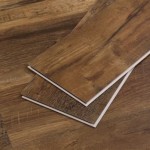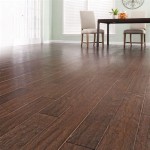Do I Need Underlayment For Vinyl Flooring With Attached Pad On Concrete?
The question of whether to install additional underlayment beneath vinyl flooring that already features an attached pad when laying it over concrete is a common one among homeowners and contractors alike. Understanding the potential benefits and drawbacks of adding an extra layer of underlayment is crucial for ensuring a successful and long-lasting flooring installation. The decision hinges on several factors, including the condition of the concrete subfloor, the specific type of vinyl flooring being used, the manufacturer's recommendations, and the desired level of comfort and performance.
Vinyl flooring with an attached pad is designed to offer enhanced comfort, sound absorption, and ease of installation. The integrated pad provides a cushioning effect underfoot, reducing fatigue and making the floor feel warmer. It also helps to dampen sound transmission between floors, creating a quieter living environment. However, the effectiveness of the attached pad can be influenced by the underlying concrete subfloor. Unevenness, moisture issues, and existing imperfections in the concrete can compromise the performance of the vinyl flooring, making the decision to add an additional underlayment a critical consideration.
Concrete, while a durable and stable subfloor, is not without its challenges. It can be prone to moisture migration from the ground, which can lead to mold and mildew growth if not properly addressed. Uneven surfaces can create unsightly dips and bumps in the finished floor, and cracks can telegraph through the vinyl, causing damage over time. Therefore, a thorough assessment of the concrete subfloor is the first step in determining whether additional underlayment is necessary.
Assessing the Concrete Subfloor
Before installing any type of flooring over concrete, a comprehensive assessment of its condition is paramount. This assessment should include visual inspection for cracks, stains, and other signs of damage. It also involves checking for levelness and moisture content. Significant cracks should be repaired with a concrete patching compound designed for this purpose. Minor surface imperfections can often be addressed with self-leveling underlayment. The use of a long, straight edge, such as a level or ruler, can help identify high and low spots in the concrete surface. The larger the discrepancies, the better reason to consider additional leveling or underlayment.
Moisture testing is a critical step, particularly for concrete slabs on or below grade. High moisture levels can damage the vinyl flooring over time, leading to warping, buckling, and the growth of mold and mildew. Several methods can be used to test for moisture, including the calcium chloride test, which measures the rate of moisture vapor emission from the concrete. Another method is the relative humidity probe test, which measures the humidity level within the concrete slab. Most flooring manufacturers have specific moisture content requirements for their products, and these requirements must be met before installation. If moisture levels exceed the allowable limits, a moisture barrier must be installed before proceeding with the flooring installation. A 6-mil polyethylene film is a common and economical choice for a moisture barrier, but specialized liquid-applied moisture barriers are also available for more challenging situations.
If the concrete subfloor exhibits significant unevenness, cracking, or moisture issues, additional underlayment can provide a valuable layer of protection and improve the overall performance of the vinyl flooring. Underlayment can help to smooth out minor imperfections in the concrete surface, reducing the risk of telegraphing and creating a more uniform and aesthetically pleasing finished floor. It can also provide an additional barrier against moisture migration, further protecting the vinyl flooring from damage.
Benefits of Additional Underlayment
Even when a vinyl flooring product has an attached pad, adding a separate underlayment layer can offer several benefits. These benefits often extend the life of the flooring, improve comfort, and protect the subfloor.
One key benefit is enhanced moisture protection. While the attached pad may offer some degree of moisture resistance, it may not be sufficient to handle high levels of moisture vapor emission from the concrete. An additional layer of underlayment with a built-in moisture barrier can provide an extra level of protection, preventing moisture from migrating through the flooring and causing damage. This is particularly important in basements or other areas where moisture is a concern.
Another benefit is improved sound insulation. While the attached pad contributes to sound absorption, adding a second layer of underlayment can further reduce noise transmission between floors. This can be particularly desirable in multi-story homes or apartments where noise reduction is a priority. Thicker underlayment options generally provide better sound insulation than thinner ones.
Increased comfort underfoot is another advantage. The combination of the attached pad and a separate underlayment layer can create a softer, more cushioned feel underfoot, reducing fatigue and making the floor more comfortable to walk on. This can be particularly beneficial in areas where people spend a lot of time standing, such as kitchens or bathrooms.
Finally, underlayment can help to bridge minor imperfections in the concrete subfloor. While it is important to address any major cracks or unevenness before installing flooring, minor surface irregularities can often be smoothed out with underlayment. This can help to prevent these imperfections from telegraphing through the vinyl flooring, creating a more uniform and aesthetically pleasing finished floor.
Factors to Consider Before Adding Underlayment
Despite the potential benefits, there are also factors to consider before deciding to install additional underlayment beneath vinyl flooring with an attached pad. Overly thick or inappropriate underlayment can actually cause problems with the flooring. It is critical to consider the manufacturer's recommendations, room height, and potential door clearance issues.
The manufacturer's recommendations for the vinyl flooring are a primary source of information. Some manufacturers may specifically prohibit the use of additional underlayment, as it can void the warranty or negatively impact the performance of the flooring. Always consult the product specifications and installation instructions before making a decision. If the manufacturer does not recommend additional underlayment, there is likely a good reason, and deviating from these recommendations can lead to problems down the road.
Room height is another important consideration. Adding a layer of underlayment will raise the height of the floor, which can be a concern in rooms with low ceilings or where there are existing transitions to other flooring types. In some cases, the added height may create a tripping hazard or make it difficult to open and close doors. It is essential to measure the existing floor-to-ceiling height and calculate the impact of adding underlayment before proceeding.
Door clearance is closely related to room height. Adding underlayment can reduce the clearance between the floor and the bottom of doors, potentially making it difficult to open and close them. In some cases, it may be necessary to trim the bottom of doors to accommodate the new floor height. This is a relatively simple task, but it should be factored into the overall cost and complexity of the flooring installation.
Finally, the type of underlayment chosen is important. There are various types of underlayment available, each with its own characteristics and performance properties. Some underlayments are specifically designed for use with vinyl flooring, while others are more general-purpose. It is important to choose an underlayment that is compatible with the vinyl flooring and that meets the specific needs of the installation. Consider factors such as moisture resistance, sound insulation, and compression resistance when selecting an underlayment.
In summary, determining whether to install additional underlayment beneath vinyl flooring with an attached pad on concrete hinges on a careful evaluation of the concrete subfloor, the benefits of underlayment in the specific application, and manufacturer recommendations. Thoroughly assessing the concrete for moisture and unevenness, confirming the allowance for additional underlayment by the vinyl flooring manufacturer, and accounting for room height and door clearance considerations will contribute to a successful and long-lasting flooring installation.

Can I Use Underlayment Under Vinyl Flooring For Warmth
:max_bytes(150000):strip_icc()/best-underlayment-laminate-flooring-4111149-hero-c971832e62864f6b922ca6efea4e93c3.jpg?strip=all)
Laminate Flooring With Pad Vs Without

What To Know Before Flooring Underlayment

Do I Need Underlayment To Install Vinyl Plank Flooring
:max_bytes(150000):strip_icc()/flooring-underlayment-1821628-hero-18d57ed5327c49d19dd20d3729bf95d3.jpg?strip=all)
Flooring Underlayment Basics What To Know

Do You Need An Underlayment For Vinyl Plank Flooring

Do You Need Underlayment For Vinyl Flooring With An Attached Pad Script Type Ld Json Context Http Schema Org Organization Name Dura Undercushions Url Https Duracushion Com Address
Spc Why It Pays To Double Down On Cushion Floor Covering News

Underlayment Buyer S Guide

What Is A Moisture Barrier And When It Needed For Flooring Inc
Related Posts








